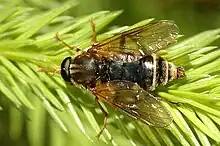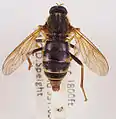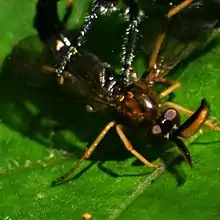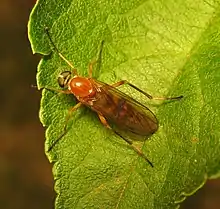| Xylophagidae | |
|---|---|
 | |
| Coenomyia ferruginea | |
| Scientific classification | |
| Domain: | Eukaryota |
| Kingdom: | Animalia |
| Phylum: | Arthropoda |
| Class: | Insecta |
| Order: | Diptera |
| Suborder: | Brachycera |
| Infraorder: | Xylophagomorpha |
| Superfamily: | Xylophagoidea |
| Family: | Xylophagidae Fallén, 1810 |
| Subfamilies | |
| |

Coenomyia ferruginea
The Brachyceran infraorder Xylophagomorpha is a small group that consists solely of the family Xylophagidae, which presently contains subfamilies that were sometimes considered to be two small related families (Coenomyiidae and Rachiceridae). Other obsolete names for members of this family include Exeretonevridae and Heterostomidae.
The family is known by the English name awl-flies.
The larvae are often predatory, consuming other insect larvae living in rotting wood.[1]
Description
Flies in this family have elongated bodies and resemble ichneumon wasps in shape. The base of the abdomen is constricted. The antennae have three segments.[1]
Genera
These nine genera belong to the family Xylophagidae:[2]
- Anacanthaspis Röder, 1889[3]
- Arthropeas Loew, 1850[4]
- Coenomyia Latreille, 1797[5]
- Dialysis Walker in Saunders, 1850[6]
- Exeretonevra Macquart, 1846[7]
- Heterostomus Bigot, 1857[8]
- Odontosabula Matsumura, 1905[9]
- Rachicerus Walker, 1854[10]
- Xylophagus Meigen, 1803[11]
References
- 1 2 Watson, L. and Dallwitz, M.J. 2003 onwards. Xylophagidae. Archived June 2, 2007, at the Wayback Machine British Insects: The Families of Diptera. Version 1 January 2012.
- ↑ Woodley, N.E. (2011). "A World Catalog of the Xylophagidae (Insecta: Diptera)". Myia. 12: 455–500.
- ↑ Röder, V. von (1889). "Anacanthaspis nov. gen. der Coenomyidae". Dipterologischer Beitrag. Wiener Entomologische Zeitung. 8: 7–10. Retrieved 7 December 2022.
- ↑ Loew, H. (1850). "Meghyperus und Arthropeas, zwei neue Dipterengattungen". Stettiner Entomologische Zeitung. 11: 302–308, 1 pl. Retrieved 7 December 2022.
- ↑ Latreille, P.A. (1797). Precis des caracteres generiques des insectes, disposes dans un ordre naturel. Bordeaux, Brive: Prevot, Paris. pp. xiv + 201 + [7]. Retrieved 29 May 2022.
- ↑ Walker, F. (1850). Diptera. Part I, pp. 1-76, pls. 1-2. In [Saunders, W. W. (ed.)], Insecta Saundersiana: or characters of undescribed insects in the collection of William Wilson Saunders, Esq., F.R.S., F.L.S., &c. Vol. 1. London: Van Voorst. p. 474.
- ↑ Macquart, P.J.M. (1846). Diptères exotiques nouveaux ou peu connus. Supplement. [1]. Lille: Mem. Soc. R. Sci. Agric. Arts. pp. 133–364, 20 pls. Retrieved 5 December 2020.
- ↑ Bigot, J.M.F. (1857). "Diptères nouveaux provenant du Chili". Annales de la Société Entomologique de France. 5 (3): 277-308. Retrieved 3 December 2022.
- ↑ Matsumura, S. (1905). Thousand insects of Japan. Tokyo: Keisei-sha. pp. 163 pp., pls 18-34.
- ↑ Walker, F. (1854). List of the specimens of dipterous insects in the collection of the British Museum. Part V. [=Supplement I]. London: British Museum. pp. 1–330.
- ↑ Meigen, J. W. (1803). "Versuch einer neuen Gattungs-Eintheilung der europaischen zweiflugligen Insekten". Mag. Insektenkd. 2: 259–281.
Gallery
 Coenomyia ferruginea mating
Coenomyia ferruginea mating Coenomyia ferruginea
Coenomyia ferruginea Museum specimen of Coenomyia ferruginea
Museum specimen of Coenomyia ferruginea Rachicerus obscuripennis being eaten by a robber fly
Rachicerus obscuripennis being eaten by a robber fly- Xylophagus ater oviposting
This article is issued from Wikipedia. The text is licensed under Creative Commons - Attribution - Sharealike. Additional terms may apply for the media files.
